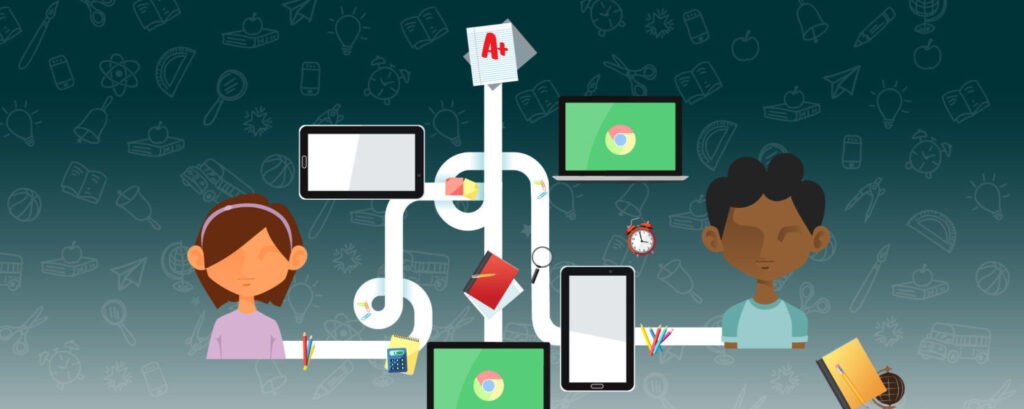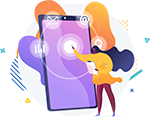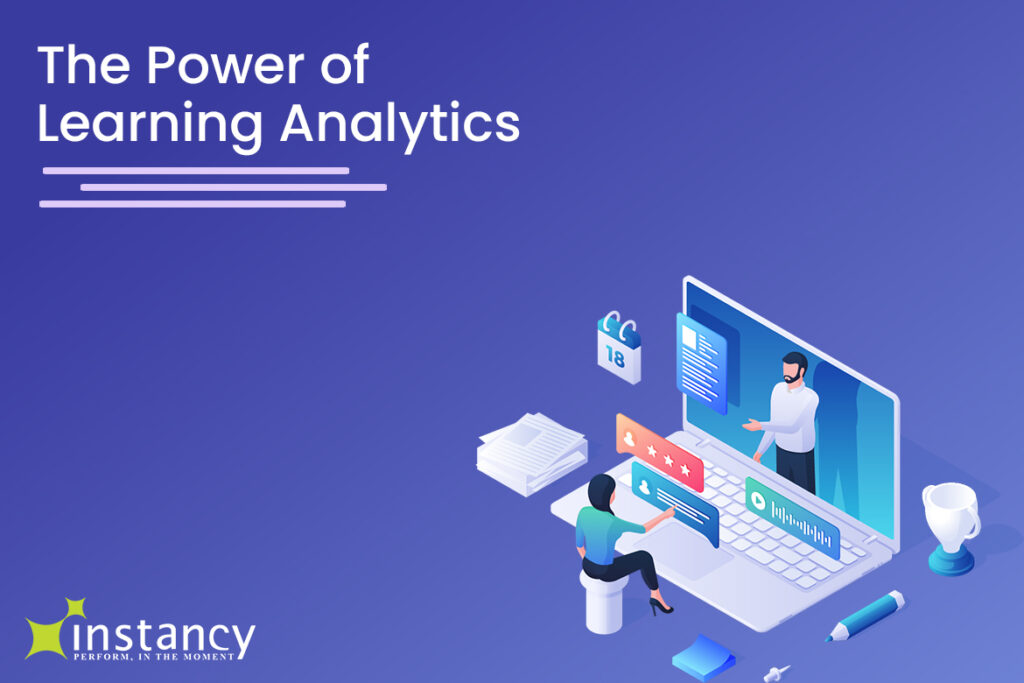Information translates to constructive learning when the instructor understands what the learner already knows and then ties it to the new information. When trying to explain the concept of the gearshift for a manual transmission car to a 10-year-old, a great way to drive the concept home would be to link it to the child’s understanding of the gears in his bike.
A one size fits all approach to learning defeats the purpose of effective exchange of information leaving many students lagging in progress, with matters getting worse as more advanced topics are communicated.
"Every learner has unique learning needs. Prior knowledge, speed of learning, and learning styles are different for each learner."
Technology can be used to deliver learning content in a variety of learning modes including video, animation, games, virtual classrooms, discussion forums, and project-based learning. Technology can also be used to reinforce learning through repetition.
With the customization and adaptation of learning techniques, the learning process becomes better suited for individual learners, given their own unique style of learning, background, specific needs, and previous experiences. Where the learner’s personal experience, habits, and knowledge are connected with learning methods, the process of learning is faster, improved, and more impactful.
Personalized learning does precisely this. It enables learners to master one topic or subject before they move on to the next subject. Some learners may learn the same subject at a fast pace whereas some may need more support or guidance and practice to master the subject.
In this article, we explore how modern technology and data analytics can provide the solution that the training and development teams have been looking for.
- What is personalized learning?
- Why adopt personalized learning?
- Will personalized learning help learners master a subject?
- Does personalized learning enable learners to progress at their own pace?
- The Power of Learning Analytics and Learning Personalization
- The Role of Big Data and Data Analytics
- What is xAPI?
- The Role of Learning Analytics in Personalizing Learning
- Conclusion
What is Personalized Learning?

The definition of Personalized learning is quite simple, it uses data analysis and data-driven insights to personalize the learning experience for each learner. It uses elements of data science to customize the learning experience. Personalized learning helps learners learn at a pace that fits their needs.
How do you personalize learning? It may take the form of short or long educational programs which also help each learner learn at a pace that suits their needs.
Why is technology-powered personalized learning an effective way to improve education? Technology-powered personalized learning can help every learner master one subject before moving on to the next.
Why Adopt Personalized Learning?
Personalized learning is useful in high schools, colleges, career colleges, technical training institutes, and for personal enrichment. Personalized learning can be achieved by changing or modifying a student’s learning program to suit their specific learning needs.
Learners learn more effectively when technology assists them. It even improves their learning experience by providing answers to questions or solutions to a problem in a known format, guiding them through an exploration of a topic, and presenting or reviewing interesting material.
Will Personalized Learning Help Learners Master a Subject?
Online learning platforms enable learners to access their course material anytime and anywhere. It allows learners to progress faster and helps them work on unique and individual learning paths.
This form of learning helps learners build a strong interest in a subject. It helps them learn in context. Technology also helps learners manage their time better and learn more in a shorter time frame.
Does Personalized Learning Enable Learners to Progress at their Own Pace?
Technology can deliver courses to individual learners through Wi-Fi-connected computers and other devices. Here, instructions are delivered through a multimedia interface that is available to every learner.
Technology can be used to provide quick remediation to learners who have difficulty mastering a subject. It can also be used by students to take assessments and tests.
For students with reading difficulties, technology can aid them by displaying graphically enhanced text for easy comprehension. It can be used to guide students through assessments and measure their learning. Personalized learning helps with the retention of information and can be used to increase the effectiveness of teaching.
Today, the reality is that students, teachers, and administrators are pushing the limits on technology to deliver the best learning possible for students. As technology evolves, we should expect to see the level of personalization grow and must learn to embrace it.
"Technology has the power to change lives by delivering personalized material that when learned can be useful and relevant to students."
Are you ready to embrace personalization and technology to deliver the best learning for your students? If yes, then it’s time we took a closer look at the power of learning analytics and the role of personalization in learning.
The Power of Learning Analytics and Personalized Learning

Learning analytics (LA) and educational data mining (EDM) can be used to personalize the learning for each learner. The use of Big Data and data analytics technologies is expected to continue to rise. Before analysis, data must be collected about each learning activity.
Advanced Distributed Learning (ADL), a US government initiative, defined a standard way to collect learner activity data called Experience API or xAPI. Collecting learner activity across all devices, tools, content, and blended learning experiences is now possible with this standard protocol.
The large volume of learning activity data, learner profiles, and various forms of content provide a very unique and new opportunity to analyze and visualize that data. Learning analytics can provide many insights about how to personalize learning. For example, pre-test data may be used to identify gaps in prerequisite knowledge.
Learning interventions are provided to the learners before they are presented with the core subject material. Learners are presented with different learning modalities based on data about other learners having similar difficulties Certain learning activities are repeated over time to reinforce knowledge retention when applicable to on-the-job performance over a long time.
The sequence of learning activities may also be altered based on learning preferences or learning progress. Learning analytics (LA) may be combined with job tasks or job performance data to automatically trigger certain learning to be assigned to the learners.
Learner feedback data may be collected and analyzed to improve instruction or provide follow-on learning activities. Data reports and dashboards can be provided to learners, instructors, subject matter experts, and managers about learning goals and progress.
LA is the use of advanced techniques, tools, and platforms to gain insights into the potential impact learning activities have on achievement and outcomes. Learning analytics can help organizations realize their mission by providing actionable insights into their learning needs. Learning analytics aims to make learning processes more successful by identifying patterns in learning practices.
The analytic reports are provided by EDM and the data is stored on a cloud computing platform such as edu-ruler.com. The data is converted into useful actionable reports, dashboards, and analytics for use in decision making, coaching, and strategic alignment. LA for personalization extends beyond a simple assessment and support to learning by attempting to enhance engagement and affect. Learning analytics is a form of analytical technique that is used to gather, organize, cleanse, and analyze learning data and the output.
The Role of Big Data and Data Analytics
The phenomenal rise in the use of technology mediation has led to unprecedented amounts of data in the way an educational institution functions and student participation in learning experiences.
Learning analytics is not a new concept. Big Data has been around for more than a decade but hasn’t been used for the purpose it is now; to teach and train and to facilitate active learning and learning innovation.
Learning analytics provides information that can lead to many exciting new areas of overall enhanced quality of learning. The application of learning analytics is allowing higher education and learning institutions to become more aware of student engagement and learning outcome data.
With this information and intelligence, it is possible to implement proactive strategies and educational interventions to support learning and retention, provide corrective feedback and other interventions, and develop better learning experiences.
- The role of big data and data analytics in learning was highlighted in the recent TEDx speech by Andrea Rosenblum of Rutgers University.
- According to one study by The George Washington University, nearly one-third of the nation’s students will be jobless within six months of graduation.
- “The number of entry-level jobs available in the workforce is not increasing as rapidly as the number of high school graduates, and there is little evidence that the economy is creating new high-skill, high-wage jobs,” Rosenblum said.
What is xAPI?
xAPI was first defined by the Government Learning Initiative (GLI) during their Big Data Challenge in March 2014. The challenge was funded by the United States Department of Education Office of Ed Tech/EduTech. To understand what xAPI is, it is helpful to take a look at what an Experience API is.
An Experience API is a standardized way to collect learner activity data about each learning experience. Before analyzing the xAPI, the data must first be pre-processed. ADL’s xAPI standard includes a self-assessment exercise to help ensure the right data is collected.
Related Read: Benefits of Experience API, xAPI and Tin Can API in eLearning Systems
The Role of Learning Analytics in Personalized Learning
Unstructured Big Data (to include not just EDM data, but also other forms of learning data) can provide an infinite amount of insights into learner performance. Data analytics can be used to understand how learners learn in the context of the learning process, how quickly learners complete a series of tasks, and how much of an impact different subjects have on their performance.
With the vast amount of data available about each learner, learning insights are now readily available to make each learner feel more connected. Learning analytics provides learners with an interactive way to relate with the learning experience. The real-time analytics from the data collected can provide learning insights.
The insights can include every learner in the process of learning. These learning insights can be combined with the role of certain learning activities and job tasks.
As a learning coach or teacher, it is important to know how to create a learning environment that can gather and analyse the learner’s data from their activities and jobs. The data collected by a learner can inform the learning environment as to the optimal way to improve the learner’s performance or to improve the learning experience for them.
A learner may not even know they are learning differently than another learner. Learning analytics and predictive analytics will play a vital role in helping educational institutions and corporations understand student performance and performance improvements.
Conclusion
Learning analytics has shown convincing evidence of transforming the way learning environments are calibrated with respect to impact and outcome. The more the data on our learners, the greater the insights we will be able to gather and use to improve educational experiences.
To explore more how to harness the power of learning analytics for personalizing learning, please schedule a call with learning experts at Instancy.




